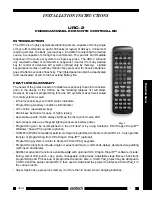
u-blox ZED-F9P Interface Description - Manual
Advance Information
6 CFG Interface
Database accessible thorough the
6.1 Configuration Database
The configuration database in the receiver's RAM holds the current configuration, which is used by the receiver
at run-time. It is constructed on startup of the receiver from several sources of configuration. These sources are
called
Configuration Layers
. The current configuration is called the
RAM Layer
. Any configuration in any layer is
organised as
Configuration Items
, which are referenced by a unique
Configuration Key ID
and hold a single
Configuration Value
.
6.2 Configuration Items
The following figure shows the structure of a
Configuration Item
, which consists of a
(Configuration) Key ID
and its
(Configuration) Value
:
A Configuration Key ID is a 32 bits integer value, which is split into three parts (Note that bits 31, 27..24 and
15..8 are reserved for future use and are currently unused.):
• bits 30..28: 3 bits that indicate the storage size of a Configuration Value (range 0x01-0x05, see below)
• bits 23..16: 8 bits that define a unique group ID (range 0x01-0xfe)
• bits 7..0: 8 bits that define a unique item ID within a group (range 0x01-0xfe)
The entire 32 bits value is the unique Key ID, which uniquely identifies a particular item. The numeric
representation of the ID uses the lower-case hexadecimal format, such as
0x20c400a1
. An easier, more
readable text representation uses the form CFG-
GROUP
-
ITEM
. This is also referred to as the
(Configuration) Key
Name
.
The storage size identifiers (bits 30..28 of the Key ID) are:
• 0x01: one bit (the actual storage used is one byte, but only the least significant bit is used)
• 0x02: one byte
• 0x03: two bytes
• 0x04: four bytes
• 0x05: eight bytes
Each Configuration Item is of a certain type, which defines the interpretation of the raw binary data (see also
• U1, U2, U4, U8: unsigned little-endian integers of 8-, 16-, 32- and 64-bit widths
• I1, I2, I4, I8: signed little-endian, two's complement integers of 8-, 16-, 32- and 64-bit widths
• R4, R8: IEEE754 single (32-bit) and double (64-bit) precision floats
• E1, E2, E4: unsigned little-endian enumeration of 8-, 16-, and 32-bit widths (like U1, U2 and U4)
• X1, X2, X4, X8: unsigned little-endian integers of 8-, 16-, 32- and 64-bit widths for bitfields and other binary
data, such as strings
UBX-18010854 - R04
Advance Information
Page 189 of 259
















































